
Self-portraits
by choronological order







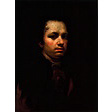 |
The first self-portrait of Goya that is known of (now in a private collection in Madrid) was painted after his return from Italy. One sees the head and shoulders of the painter, with a round face and long brown curly hair, against a neutral background. The painter already appears to have the ability to transmit a psychological vision of himself as a young rebel, bohemian (indicated by the long hair), and ambitious.
According to an old tradition, he painted his portrait in his forementioned Sermon of San Bernardino of Siena (Church of San Francisco el Grande, Madrid, 1781-1784). Like Velázquez (in Las Meninas), whose painting Goya admired, studied and copied in an etching, Goya included himself as painter in the portrait of the family of the Infante Luis de Bourbon (1784, Fundación Magnani-Rocca, Corte di Mamiano, Parma), brother of Carlos III and one of the first of Goya's patrons at Court. One year previously Goya had "presented" himself in the portrait of the Count of Floridablanca (Banco de España, Madrid). The artist, with his back to the viewer shows a painting to the minister for his approval (perhaps a sketch of the "Sermon of San Bernardino of Siena" ?). In the Museum of Agen (France), there is another self-portrait of the painter posing before a canvas. The work is of the same year as the previous one, when the painter was 37. In the Museum of Fine Arts in Boston, there is a sketch which only reveals the bust of the artist wearing a wig. In the period 1790-1795 he painted the small self-portrait now in the Academia de San Fernando. The whole body is seen and the painter is wearing a strange hat which served as a support for candles enabling him to work at night. There are another two self portraits in the Metropolitan Museum of Art in New York, the first with tricorne, done in brush and sepia (Lehman legacy, approx. 1785-1795) and the second, somewhat later (approx. 1800, brush with gray wash). In this work Goya stares at the viewer, with the shoulders hardly sketched in, with long unkempt hair and long sideburns that meet to form a beard. The image, which could rightly be called Romantic, reminds the viewer of Goya's contemporary, Beethoven. A similar portrait can be seen in a small oil painting (20 x 14 cm.) in the old Pidal collection, in which Goya, elegantly dressed in frock coat, shirt and tie, poses before a large canvas (approx. 1795-97). Amongst the preparatory sketches for the Caprichos (published in 1799) there is a self-portrait of the artist's head and shoulders (in the print part of the shoulders do not appear), in which the elegance of the artist's attire stands out, an elegance completed by a top hat. On the other side of the sketch are two small studies of his face, looking directly out at the viewer. The Comentarios of Manuscript 3 adds the note 'True portrait of him with bad humour and satirical gesture'. Another two (1, 2) appear in the preparatory drawings for print no. 43, The Dream of Reason Brings Forth Monsters (Prado, 1797) which the painter thought for a long time would be the frontispiece of the collection. Goya appears in another print next to a woman who has been identified as the Duchess of Alba in the preliminary drawing (Museo del Prado) for the print Dream of Lies and Inconstancy (Biblioteca Nacional, Madrid), one of the Caprichos not included in the collection. The plate for this print was destroyed. Around the period of the Caprichos are two self-portraits of short bust, both with the artist wearing glasses, both of which are very similar (Musée Goya, Castres y Musée Bonnat, Bayona). Family of Charles IV (1800-1801, Prado) is a collective portrait of a formal and iconological type (see PORTRAITS). The formal inspiration of Velázquez's Las Meninas encouraged Goya to include himself in the painting with the same pose as Velázquez. At 69 years of age, in 1815, he painted the self-portrait later donated to the Academia de San Fernando by his son Javier. The signature is expressive, Francisco de Goya, Aragonese Painted by Himself. It is very similar to the portrait in The Museo del Prado and was painted around the same period. In 1820, another grave illness brought him close to death. Doctor Arrieta cured him and a grateful Goya painted a self-portrait (Minneapolis Institute of Arts, U.S.A.) in which the doctor half lifts Goya from the bed to give him a glass of medicine. In the dark background appear three female figures which are also subjects of the Black Paintings. The painting, with a complex perspective, in which Velazquez has again been used as inspiration for study, is a civil and lay offering. The last known self-portrait is a drawing of 1824 (Museo del Prado), short bust, in profile, with a hat. It may remind the viewer of the frontispiece of the Caprichos. Few portraits of Goya were painted in his lifetime. The Italian Gaetano Merchi (1747-1825) made a bust of him in bronze (Academia de San Fernando, Madrid) and the Court Painter of Fernando VII and Goya's successor, Vicente López, painted a portrait of Goya in 1826 (Prado Museum), which is a model portrait for a long series of images of the Aragonese painter that have lasted to the present day. See also:BibliographyGÁLLEGO, Julián. Autorretratos de Goya. Zaragoza, 1978. WILSON-BAREAU, Juliet. Goya : La década de los Caprichos : Dibujos y aguafuertes. Madrid, 1992. (Catalogue of the exhibition of the Academia de San Fernando). Ricardo Centellas |
|
| Self-portrait | ||
 |
||
| Sermon of St. Bernardino de Siena | ||
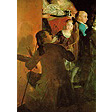 |
||
| Family fo the Infante Luis de Borboun (Detail) | ||
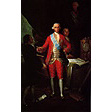 |
||
| The Count of Floridablanca | ||
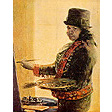 |
||
| Self-portrait at work at night (Detail) | ||
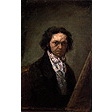 |
||
| Self-portrait | ||
 |
||
| Self-portrait with glasses (Musée Goya, Castres) | ||
 |
||
| Self-portrait with glasses (Musée Bonnat, Bayona) | ||
 |
||
| Self-portrait at his 69 years of age | ||
 |
||
| Goya cured by doctor Arrieta |
 |
InfoGoya 96 is an initiative of the University of Zaragoza, sponsored by the Institution Fernando el Católico of the Deputation of Zaragoza on an Apple Internet Server donated by Apple Computer. |    |